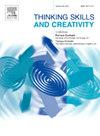Extracting the actions of contextual understanding in STEAM research: Direction for STEAM course design
IF 3.7
2区 教育学
Q1 Social Sciences
引用次数: 0
Abstract
The arts could be a catalyst to engage students in science, technology, engineering, and mathematics (STEM) education. Combining science, technology, engineering, art, and mathematics (STEAM) is more likely to help students comprehend how scientific knowledge and practices relate to the problems they encounter daily. By encouraging students’ reflections on the sociocultural environment, other people's perspectives, and science history through STEM instruction, “contextual understanding” refers to the most distinctive meaning of art that can highlight the distinctiveness of each context. However, as the meaning of contextual understanding is fairly abstract and concrete actions that learners must display when engaging in STEAM activities have not been defined, it is difficult to provide directions for designing STEAM courses. Thus, we aimed to validate a coding scheme that included four concrete actions of contextual understanding: identification, analysis, moral response, and exhibition. Eleven STEAM researchers participated in the semi-structured interviews. The coding scheme was validated by revealing a fairly similar pattern. Most STEAM researchers concentrated on identifying students in their personal and community histories, fostering their analysis skills, particularly clarifying context by perspective-taking, and letting them demonstrate their learning through explanatory exhibitions in scientific and historical ways; only one researcher instructed students to reflect on ethics.
提取STEAM研究中的语境理解行为:STEAM课程设计的方向
艺术可以成为让学生参与科学、技术、工程和数学(STEM)教育的催化剂。结合科学、技术、工程、艺术和数学(STEAM)更有可能帮助学生理解科学知识和实践如何与他们日常遇到的问题联系起来。通过STEM教学,鼓励学生对社会文化环境、他人观点和科学史的思考,“语境理解”是指艺术最独特的意义,可以突出每个语境的独特性。然而,由于语境理解的含义是相当抽象的,学习者在参与STEAM活动时必须表现出的具体动作并没有明确的定义,因此很难为STEAM课程的设计提供指导。因此,我们的目的是验证一个编码方案,其中包括语境理解的四个具体行动:识别、分析、道德反应和展示。11名STEAM研究人员参加了半结构化访谈。通过揭示一个相当相似的模式来验证编码方案。大多数STEAM研究人员专注于识别学生的个人和社区历史,培养他们的分析能力,特别是通过观点分析来澄清背景,并让他们通过科学和历史的方式展示他们的学习;只有一名研究人员要求学生思考道德问题。
本文章由计算机程序翻译,如有差异,请以英文原文为准。
求助全文
约1分钟内获得全文
求助全文
来源期刊

Thinking Skills and Creativity
EDUCATION & EDUCATIONAL RESEARCH-
CiteScore
6.40
自引率
16.20%
发文量
172
审稿时长
76 days
期刊介绍:
Thinking Skills and Creativity is a new journal providing a peer-reviewed forum for communication and debate for the community of researchers interested in teaching for thinking and creativity. Papers may represent a variety of theoretical perspectives and methodological approaches and may relate to any age level in a diversity of settings: formal and informal, education and work-based.
 求助内容:
求助内容: 应助结果提醒方式:
应助结果提醒方式:


